Sage Bundle
Who Really Owns Sage Group plc?
Understanding the ownership structure of a company is key to grasping its strategic direction and market influence. Sage Group plc, a global leader in enterprise software, presents a fascinating case study. This article dives deep into Sage SWOT Analysis, tracing the evolution of Sage's ownership from its humble beginnings to its current status as a publicly traded giant.
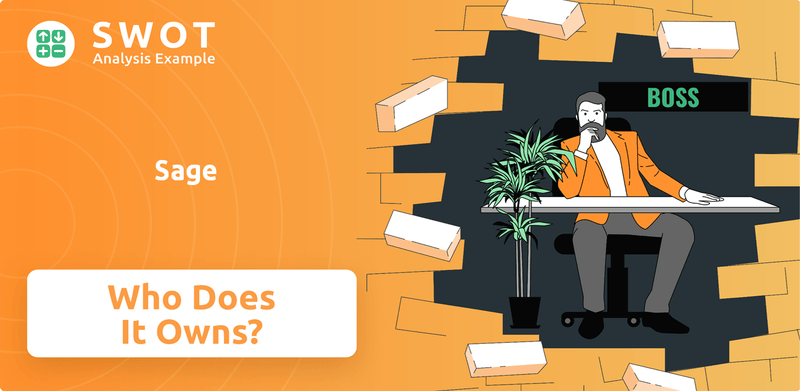
From its 1989 listing on the London Stock Exchange, Sage's ownership has broadened considerably, impacting everything from its business model to its financial performance. We'll explore the major shareholders, the company's history, and the key players shaping Sage's future. Discover the answers to "Who owns Sage" and gain valuable insights into this prominent technology company's journey.
Who Founded Sage?
The initial formation of the Sage Group plc in 1981 marked the beginning of a significant player in the business software sector. The company was founded in Newcastle upon Tyne, England, by David Goldman, Paul Muller, and Graham Wylie. Their primary aim was to develop accounting and estimating software designed specifically for small businesses.
Graham Wylie, while a student at Newcastle University, developed the foundational accounting program during a summer job. This program became the cornerstone for Sage Line 50. David Goldman, recognizing the potential, brought Wylie and academic Paul Muller on board to formally establish the company. This early focus on practical, accessible software set the stage for the company's future growth and market positioning.
Initially, the software was marketed to printing companies. However, the company quickly expanded its reach through a network of resellers. The launch of 'Sage software' for the Amstrad PCW word processor in 1984 significantly boosted sales. The company's founders, including David Goldman, Wylie, Muller, and Phil Lever, saw the broader market potential and formed Sage Systems.
The initial product was accounting software tailored for small businesses.
David Goldman, Paul Muller, and Graham Wylie were the key founders.
Initially sold to printing companies, then expanded through resellers.
The launch of software for the Amstrad PCW boosted sales significantly.
David Goldman retired in 1997, and Michael Jackson became chairman.
Sales increased from 30 copies a month to over 300 copies after the Amstrad PCW launch.
While specific equity splits at the company's inception are not publicly detailed, David Goldman played a crucial role in the early marketing and strategic direction of the company. Goldman retired in 1997, and Michael Jackson, who had been a board member since 1984, took over as chairman. As of the latest financial reports, the company continues to be a significant player in the global market, with a focus on providing software solutions to small and medium-sized businesses. The company's market capitalization as of late 2024 was approximately £12 billion, reflecting its sustained presence and growth in the software industry. The company's revenue for the fiscal year 2024 was reported at around £2.2 billion, demonstrating a consistent financial performance.
Sage SWOT Analysis
- Complete SWOT Breakdown
- Fully Customizable
- Editable in Excel & Word
- Professional Formatting
- Investor-Ready Format
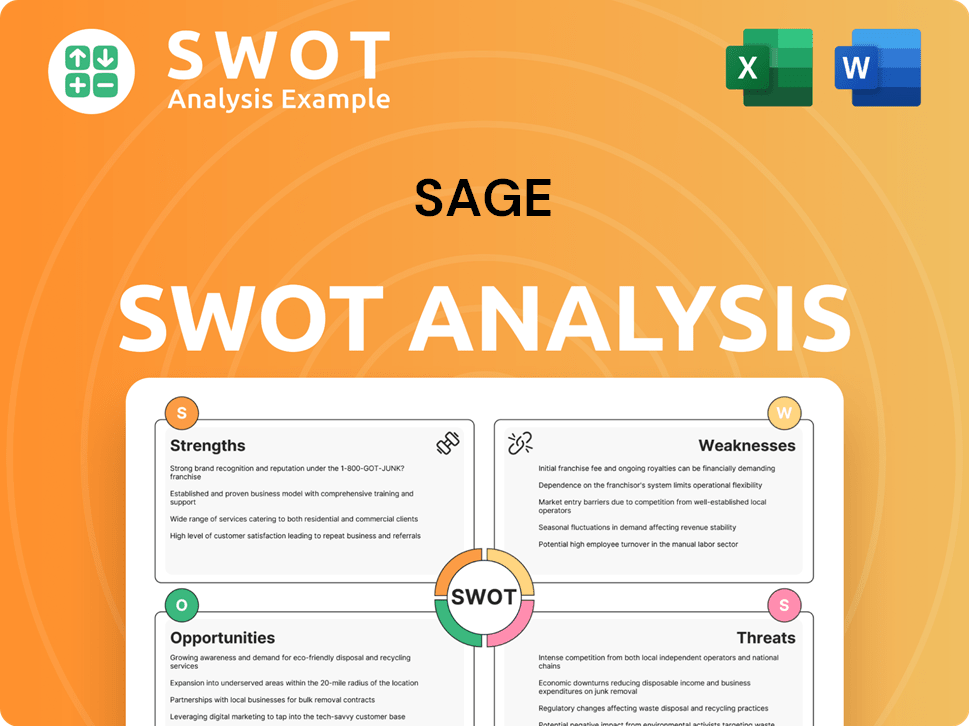
How Has Sage’s Ownership Changed Over Time?
The ownership structure of Sage Group plc, or who owns Sage, has transformed significantly since its inception. The company's initial public offering (IPO) in 1989 on the London Stock Exchange marked a pivotal moment, transitioning ownership to public shareholders and fueling its expansion. This IPO provided the necessary capital for growth and set the stage for future developments in its shareholder base.
Following the IPO, the involvement of institutional investors has become increasingly prominent. Key acquisitions, such as Dac Software, Inc. in 1991 and Peachtree in 1999, also impacted the company's equity allocation. The company's financial performance, particularly its recurring revenue model, further influences investor interest. For the fiscal year ending September 30, 2024, Sage reported revenue of £2,332 million, with 97% of it being recurring revenue, which is attractive to institutional investors.
| Event | Impact on Ownership | Year |
|---|---|---|
| Initial Public Offering (IPO) | Transitioned from private to public ownership, opening up shares to the public. | 1989 |
| Acquisition of Dac Software, Inc. | Integration of another company into the group, affecting equity and market presence. | 1991 |
| Acquisition of Peachtree | Further expansion of market presence and integration of new products. | 1999 |
Institutional investors like Vanguard Group and BlackRock hold significant stakes in Sage Group plc. While specific percentages from the most recent filings (2024-2025) are not immediately available, these large asset managers typically represent a substantial portion of public company ownership. This influences market stability and investor confidence, reflecting the ongoing evolution of Sage's ownership structure. If you're interested in learning more about the company, you might find this article about Sage helpful.
Sage's ownership has evolved significantly since its IPO, with institutional investors playing a major role.
- The IPO in 1989 opened ownership to public shareholders.
- Institutional investors like Vanguard and BlackRock hold significant stakes.
- Acquisitions have played a key role in expanding the company.
- Strong recurring revenue is attractive to investors.
Sage PESTLE Analysis
- Covers All 6 PESTLE Categories
- No Research Needed – Save Hours of Work
- Built by Experts, Trusted by Consultants
- Instant Download, Ready to Use
- 100% Editable, Fully Customizable
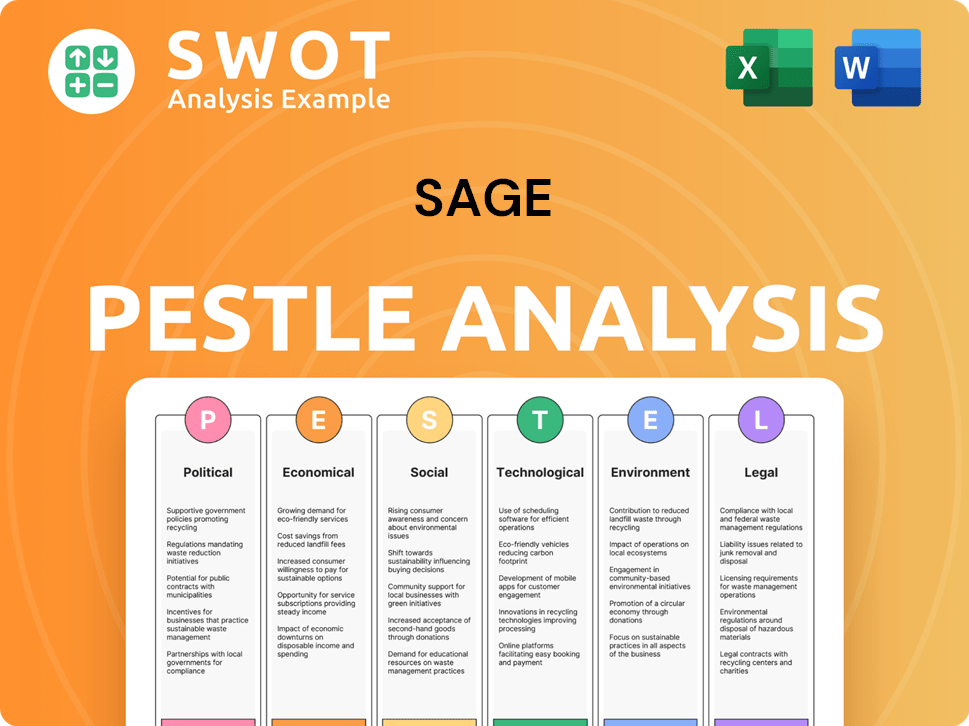
Who Sits on Sage’s Board?
The current board of directors of Sage Group plc, as of June 11, 2025, is responsible for the company's governance and strategic direction. The board is led by Andrew Duff, who serves as the Non-Executive Independent Chairman, appointed in 2021. Steve Hare, the Chief Executive Officer and an Executive Director since January 2014, was appointed CEO in November 2018. Jonathan Howell is the Chief Financial Officer and an Executive Director, appointed in 2018.
The board also includes several non-executive independent directors, such as Lori Mitchell-Keller, who joined the board on February 7, 2025, bringing extensive experience in technology transformation. Other non-executive independent directors include John Bates, Jonathan Bewes, Annette Court (Senior Non-Executive Independent Director), Roisin Donnelly, Derek Harding, and Maggie Jones. Sangeeta Anand, a non-executive director since May 2020, stepped down in February 2025.
| Director | Position | Appointment Date |
|---|---|---|
| Andrew Duff | Non-Executive Independent Chairman | 2021 |
| Steve Hare | Chief Executive Officer and Executive Director | January 2014 (Executive Director), November 2018 (CEO) |
| Jonathan Howell | Chief Financial Officer and Executive Director | 2018 |
| Lori Mitchell-Keller | Non-Executive Independent Director | February 7, 2025 |
The voting structure of Sage Group plc typically follows a one-share-one-vote basis, common among publicly listed companies on the London Stock Exchange. The board's composition, with a significant number of independent non-executive directors, aims to ensure balanced decision-making and accountability to all shareholders. The average tenure of the management team is 5.3 years, and the board of directors is 5.2 years. To understand the competitive environment, consider the Competitors Landscape of Sage.
The board includes key figures like Andrew Duff (Chairman) and Steve Hare (CEO). Non-executive directors bring diverse expertise.
- Andrew Duff, Non-Executive Independent Chairman.
- Steve Hare, Chief Executive Officer.
- Jonathan Howell, Chief Financial Officer.
- Lori Mitchell-Keller, Non-Executive Independent Director.
Sage Business Model Canvas
- Complete 9-Block Business Model Canvas
- Effortlessly Communicate Your Business Strategy
- Investor-Ready BMC Format
- 100% Editable and Customizable
- Clear and Structured Layout
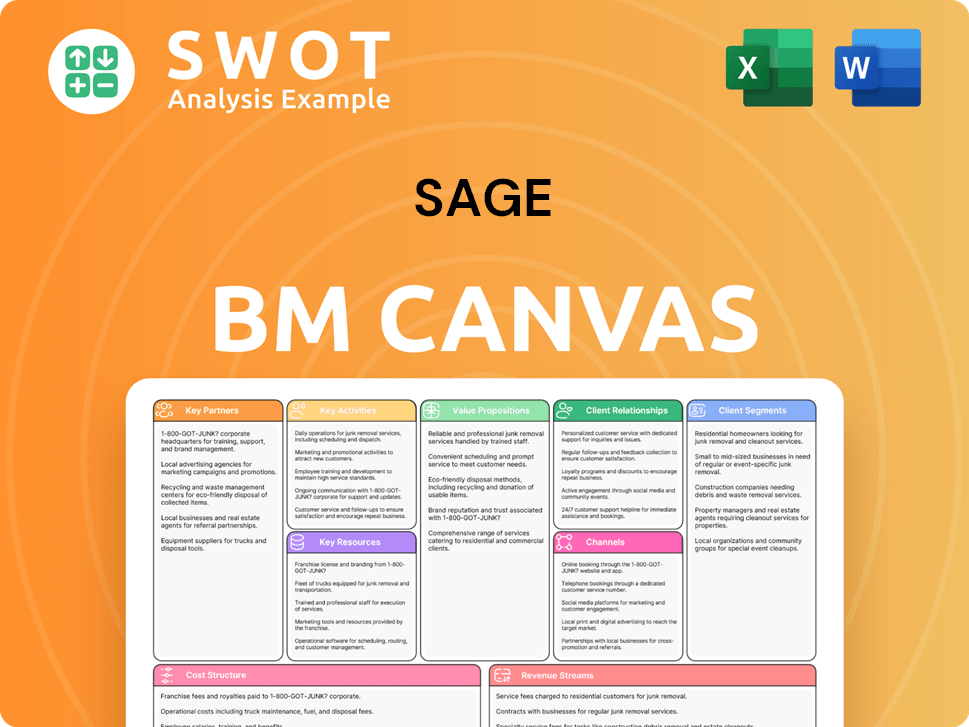
What Recent Changes Have Shaped Sage’s Ownership Landscape?
Over the past few years, the ownership profile of Sage Group plc has been influenced by its strategic focus on cloud solutions and strong financial results. For the fiscal year ending September 30, 2024, the company reported an 11% increase in underlying Annual Recurring Revenue (ARR), reaching £2,339 million. Organic ARR also rose by 11% to £2,334 million. Sage Business Cloud revenue saw a 16% increase, reaching £1,871 million, with cloud-native revenue growing by 23% to £732 million. Subscription penetration increased to 82% in FY24 from 79% in FY23, with subscription revenue growing by 13% to £1,910 million. These figures highlight the company's shift towards a subscription-based cloud model.
Leadership changes have also occurred, impacting the company's governance. Lori Mitchell-Keller was appointed as a Non-executive Director, effective February 7, 2025. Additionally, Sangeeta Anand announced in October 2024 that she would not seek re-election at the February 2025 Annual General Meeting. These changes are part of ongoing board refreshment efforts. The Annual Report and Accounts for the fiscal year ended September 30, 2024, were released in December 2024, providing investors with detailed financial performance and strategic insights.
The company's consistent growth and focus on cloud solutions are likely to attract continued institutional investment. Sage's commitment to aiding small and mid-sized businesses (SMBs) through its finance, HR, and payroll software, along with its broader mission to address digital inequality, economic inequality, and the climate crisis, also shapes its appeal to a diverse investor base. While specific large-scale share buybacks or secondary offerings in the 2024-2025 timeframe are not prominently detailed, the company's performance and strategic direction continue to influence its ownership structure.
Underlying ARR increased by 11% to £2,339 million. Organic ARR also increased by 11% to £2,334 million. Subscription revenue grew by 13% to £1,910 million. Subscription penetration increased to 82%.
Lori Mitchell-Keller appointed as Non-executive Director, effective February 7, 2025. Sangeeta Anand will not seek re-election at the February 2025 AGM. These changes are part of ongoing board refreshment.
Sage Porter's Five Forces Analysis
- Covers All 5 Competitive Forces in Detail
- Structured for Consultants, Students, and Founders
- 100% Editable in Microsoft Word & Excel
- Instant Digital Download – Use Immediately
- Compatible with Mac & PC – Fully Unlocked
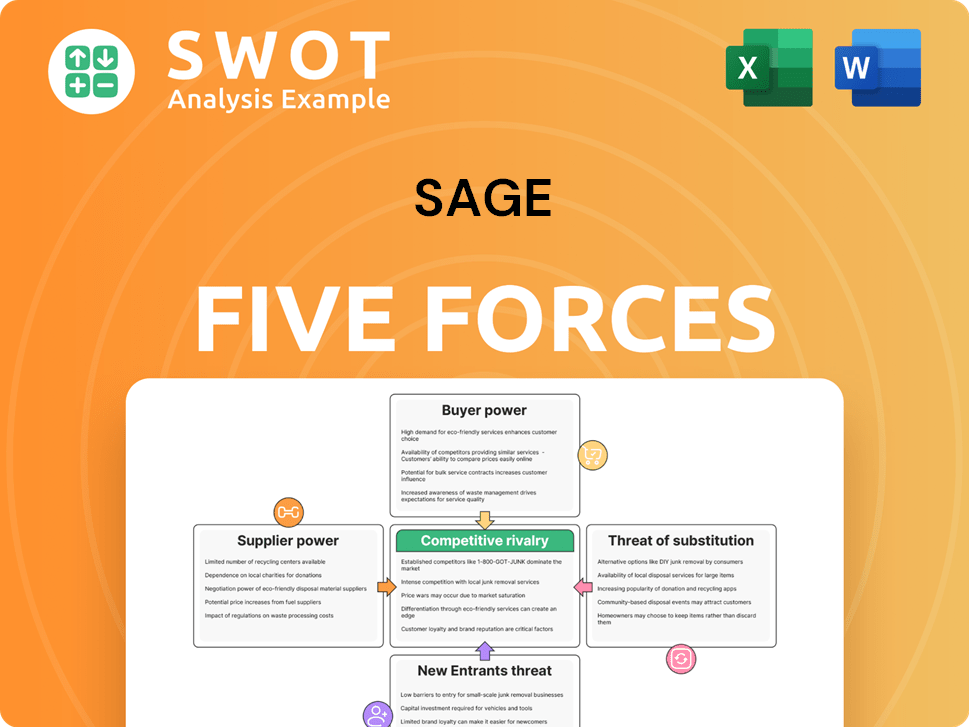
Related Blogs
- What are Mission Vision & Core Values of Sage Company?
- What is Competitive Landscape of Sage Company?
- What is Growth Strategy and Future Prospects of Sage Company?
- How Does Sage Company Work?
- What is Sales and Marketing Strategy of Sage Company?
- What is Brief History of Sage Company?
- What is Customer Demographics and Target Market of Sage Company?
Disclaimer
All information, articles, and product details provided on this website are for general informational and educational purposes only. We do not claim any ownership over, nor do we intend to infringe upon, any trademarks, copyrights, logos, brand names, or other intellectual property mentioned or depicted on this site. Such intellectual property remains the property of its respective owners, and any references here are made solely for identification or informational purposes, without implying any affiliation, endorsement, or partnership.
We make no representations or warranties, express or implied, regarding the accuracy, completeness, or suitability of any content or products presented. Nothing on this website should be construed as legal, tax, investment, financial, medical, or other professional advice. In addition, no part of this site—including articles or product references—constitutes a solicitation, recommendation, endorsement, advertisement, or offer to buy or sell any securities, franchises, or other financial instruments, particularly in jurisdictions where such activity would be unlawful.
All content is of a general nature and may not address the specific circumstances of any individual or entity. It is not a substitute for professional advice or services. Any actions you take based on the information provided here are strictly at your own risk. You accept full responsibility for any decisions or outcomes arising from your use of this website and agree to release us from any liability in connection with your use of, or reliance upon, the content or products found herein.